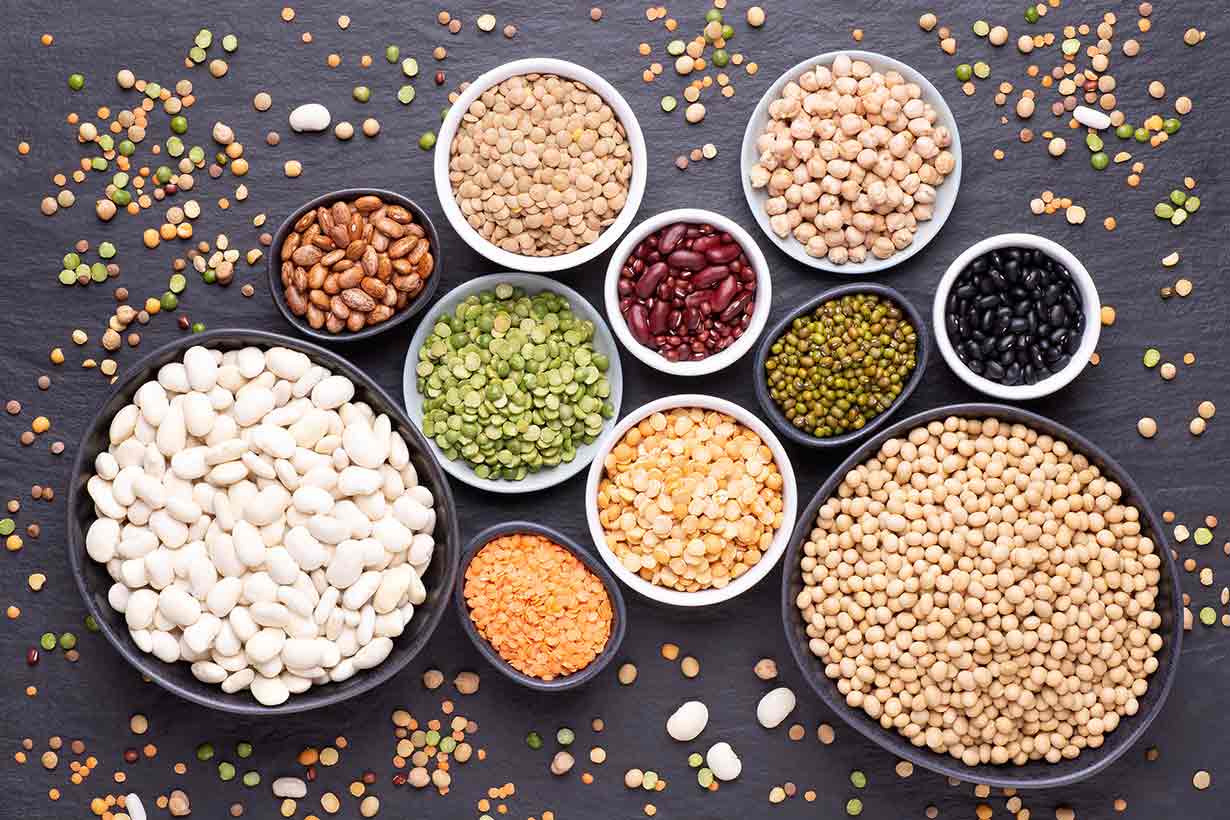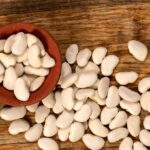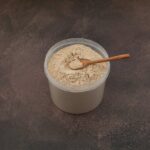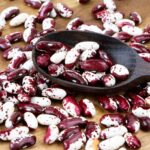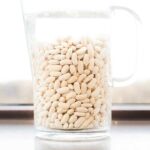Pinto beans are a nutrient-rich legume with a speckled surface.
But are these little beans worth including in your diet?
In this article, we’ll help answer that question by identifying the key nutrients they provide, examining their potential benefits, and providing their full nutritional profile.
Pinto Beans At-a-glance
- High in essential nutrients: Pinto beans offer an excellent provision of both fiber and protein—a cup of cooked pinto beans provides over 15 grams of fiber and 15 grams of protein. They are also a rich source of folate, copper, and manganese.
- Potential health benefits: Recent studies suggest pinto beans may have benefits for gut health as well as for lowering blood sugar levels and markers of heart disease risk.
- Improving diet quality: Research shows that adding pinto beans to the diet improves diet quality by raising intake of key essential nutrients.
Important Note: The content in this article is for informational and educational purposes only. It should not replace medical advice from your healthcare provider.
Table of contents
1) Pinto Beans and Heart Health
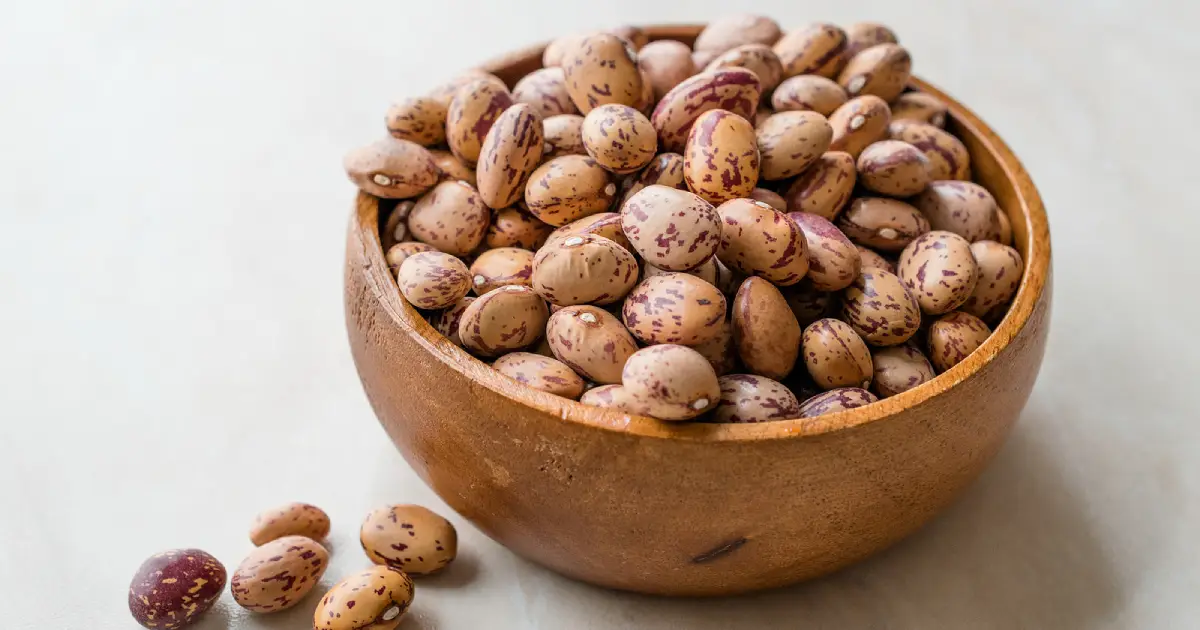
A randomized controlled trial involving 16 participants with mild insulin resistance examined the impact of pinto bean consumption on markers of heart disease risk (1).
Over eight weeks, daily intake of half a cup of pinto beans significantly lowered “bad” LDL cholesterol (LDL-C) and total cholesterol.
This is an older study from 2007, and there has been little human research on the topic specifically focused on pinto beans since then.
However, recent research appears to support the finding:
- A 2023 systematic review and meta-analysis found that randomized controlled trials supported beans and legumes in general having an effect on lowering LDL-C (2).
- An earlier 2021 systematic review of 23 clinical and randomized controlled trials found that “common bean” intake lowered LDL-C, and specifically mentioned a large observational study’s finding that pinto bean intake lowered the risk of cardiovascular disease (CVD) by 11%. The authors concluded that pinto beans “seem to have potential for reducing CVD” (3).
Like most legumes, pinto beans are high in soluble fiber, which research has shown to help lower cholesterol and LDL-C (4).
Since lowering elevated levels of LDL-C has been shown to reduce heart disease risk, including pinto beans in a well-formulated diet may help to improve heart health (5).
2) Pinto Beans Improve Diet Quality
Pinto beans contain an assortment of beneficial, essential nutrients.
Per cup of cooked pinto beans, these nutrients include high levels of (6):
- Protein: 15.4 g
- Fiber: 15.4 g
- Folate: 74% of the daily value (% DV)
- Copper: 42% DV
- Manganese: 34% DV
- Thiamin (B1): 28% DV
- Phosphorus: 25% DV
- Vitamin B6: 23% DV
- Magnesium: 20% DV
- Iron: 20% DV
Given their rich provision of nutrients, it isn’t surprising to see research validates their impact on diet quality.
For example, a 2024 analysis of data from the US National Health and Nutrition Examination Survey (NHANES), 2001-2018 found that diets including pinto beans, kidney beans, chickpeas, or black beans were linked with “significantly higher diet quality scores” and “greater intake of shortfall nutrients” (7).
3) Pinto Beans and Blood Sugar
Adding pinto beans to the diet may help with controlled post-meal blood sugar levels—at least compared to refined carbohydrates:
A 2012 randomized controlled trial found that, in 17 adults with type 2 diabetes, adding pinto beans to white rice lowered blood glucose levels 1 hour, 2 hours, and 3 hours after eating (8).
The study matched the carbohydrate content of the white rice control and the mixed pinto beans and white rice meal to 50 grams. However, the pinto beans and white rice had significantly more fiber, which may partially explain the difference in blood sugar response.
More recent studies provide mixed evidence for beans and legumes potentially supporting blood sugar improvements:
- A 2023 systematic review and meta-analysis found that randomized controlled trials show legume consumption lowers fasting blood glucose compared to controls (2). That said, no influence on type 2 diabetes risk was seen in observational studies.
- Additionally, a 2019 umbrella review of observational studies found that the highest intake of legumes had no association with diabetes risk compared to the lowest (9).
The current research shows that adding pinto beans to your diet may help to lower post-meal blood glucose, particularly if replacing refined grains like white rice. However, further research is necessary to better understand the impact on type 2 diabetes risk.
4) Pinto Beans and Gut Health
Some research indicates that pinto beans may have a beneficial impact on gut health.
First, it is known that gut bacteria feed on fiber, and fiber-rich diets can lead to beneficial changes in the gut microbiota. For example, a 2018 systematic review and meta-analysis demonstrated that dietary fiber interventions appear to exert beneficial effects on the microbiome (10).
- Several recent studies in mice indicate that pinto bean supplementation beneficially changed the presence of gut bacteria, leading to a profile associated with lower inflammation (11, 12, 13).
- Studies in animal models are generally weak evidence, but they can be useful to connect the wider research base. In this sense, a 2020 systematic review looking at dietary pulses and beans found mixed evidence that they could impact the gut microbiota in humans. However, one randomized controlled trial included in the review showed pinto bean intake led to changes in gut bacteria (14, 15).
At this point, there is a lack of high-quality human studies specifically focused on pinto beans and gut health.
However, based on what we know about fiber in general, it is likely that pinto beans have a positive impact on the gut microbiome—and general health—through their high fiber content (16, 17).
What Nutrients Do Pinto Beans Contain?
Now that we have examined some of the potential benefits of pinto beans, let’s explore their nutritional profile in depth.
Using data from the USDA FoodData Central database, the following tables present the complete nutritional values of cooked pinto beans per 100 grams and per 171-gram cup serving (6).
Calories and Macronutrients
| Nutrient | Per 100 g | Per 171 g cup |
|---|---|---|
| Calories | 143 kcal | 245 kcal |
| Carbohydrates | 26.2 g (10% DV) | 44.8 g (16% DV) |
| Fiber | 9.0 g (32% DV) | 15.4 g (55% DV) |
| Sugars | 0.34 g | 0.58 g |
| Fat | 0.65 g (1% DV) | 1.11 g (1% DV) |
| Saturated fat | 0.14 g (1% DV) | 0.23 g (1% DV) |
| Monounsaturated fat | 0.13 g | 0.23 g |
| Polyunsaturated fat | 0.24 g | 0.40 g |
| Omega-3 | 0.14 g | 0.23 g |
| Omega-6 | 0.10 g | 0.17 g |
| Protein | 9.01 g (18% DV) | 15.4 g (31% DV) |
| Cholesterol | 0 mg (0% DV) | 0 mg (0% DV) |
Pinto beans are an excellent source of fiber, being one of the most fiber-rich beans. They are also high in protein and low in sugar and fat.
Vitamins
| Vitamin | Per 100 g | Per 171 g cup |
|---|---|---|
| Vitamin A (RAE) | 0 mcg (0% DV) | 0 mcg (0% DV) |
| Vitamin C | 0.8 mg (1% DV) | 1.37 mg (2% DV) |
| Vitamin D | 0 mcg (0% DV) | 0 mcg (0% DV) |
| Vitamin E | 0.94 mg (6% DV) | 1.61 mg (11% DV) |
| Vitamin K | 3.5 mcg (3% DV) | 5.98 mcg (5% DV) |
| Thiamin (B1) | 0.19 mg (16% DV) | 0.33 mg (28% DV) |
| Riboflavin (B2) | 0.06 mg (5% DV) | 0.11 mg (8% DV) |
| Niacin (B3) | 0.32 mg (2% DV) | 0.54 mg (3% DV) |
| Pantothenic acid (B5) | 0.21 mg (4% DV) | 0.36 mg (7% DV) |
| Vitamin B6 | 0.23 mg (14% DV) | 0.39 mg (23% DV) |
| Folate (B9) | 172 mcg (43% DV) | 294 mcg (74% DV) |
| Vitamin B12 | 0 mcg (0% DV) | 0 mcg (0% DV) |
| Choline | 35.3 mg (6% DV) | 60.4 mg (11% DV) |
Among their vitamin profile, pinto beans are highest in thiamin and folate, providing significant amounts of each vitamin.
Minerals
| Mineral | Per 100 g | Per 171 g cup |
|---|---|---|
| Calcium | 46 mg (4% DV) | 78.7 mg (6% DV) |
| Iron | 2.09 mg (12% DV) | 3.57 mg (20% DV) |
| Magnesium | 50 mg (12% DV) | 85.5 mg (20% DV) |
| Phosphorus | 147 mg (12% DV) | 251 mg (20% DV) |
| Potassium | 436 mg (9% DV) | 746 mg (16% DV) |
| Sodium | 1 mg (<1% DV) | 1.71 mg (<1% DV) |
| Zinc | 0.98 mg (9% DV) | 1.68 mg (15% DV) |
| Copper | 0.22 mg (24% DV) | 0.37 mg (41% DV) |
| Manganese | 0.45 mg (20% DV) | 0.76 mg (33% DV) |
| Selenium | 6.2 mcg (11% DV) | 10.6 mcg (19% DV) |
Pinto beans contain a broad range of minerals in moderate to high quantities.
Pinto Beans Are a Highly Nutritious Choice
In summary, pinto beans are an excellent dietary addition that offer a lot nutritionally.
High-level studies, including systematic reviews and meta-analyses, suggest they may have benefits for heart health, blood sugar regulation, gut health, and improving diet quality.
In addition to these potential benefits, we know that pinto beans are a rich source of protein, fiber, folate, thiamin, and magnesium—and the benefits of getting sufficient amounts of these essential nutrients are well known.

